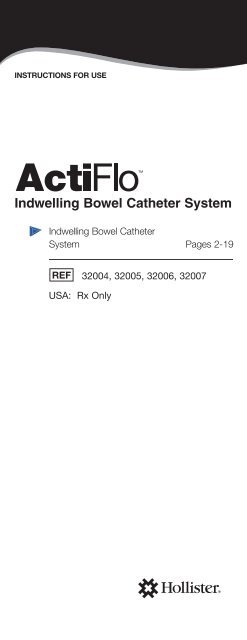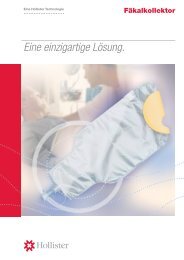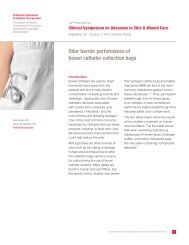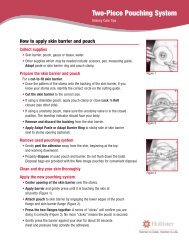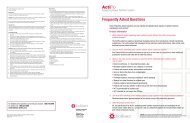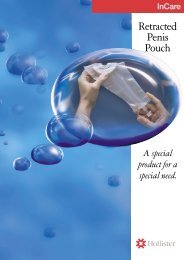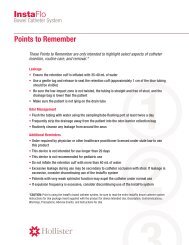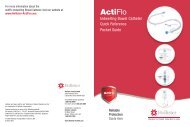Indwelling Bowel Catheter System - Hollister Incorporated
Indwelling Bowel Catheter System - Hollister Incorporated
Indwelling Bowel Catheter System - Hollister Incorporated
- No tags were found...
Create successful ePaper yourself
Turn your PDF publications into a flip-book with our unique Google optimized e-Paper software.
• Avoid inserting anything (e.g., thermometer, suppository, etc.) intothe anal canal with the catheter in place to minimize the chanceof patient injury or catheter damage.• Care should be taken when disconnecting the syringe from theCLEAR connector (IRRIG/Rx). Fluids that are retained in the rectumand colon may drain or splatter from the connector when it isdisconnected.• Use WATER ONLY to inflate the retention cuff. Do not use salinesolution, which may adversely affect valve function.• Use AIR ONLY to inflate the intraluminal balloon. Do not use wateror any other fluid.• Do not use vigorous aspiration to remove fluid from the retentioncuff or to remove air from the intraluminal balloon. Vigorousaspiration may collapse the inflation lumen and/or pilot balloon,and may prevent retention cuff or intraluminal balloon deflation.• Do not allow ointments or lubricants having a petroleum base(e.g., Vaseline ® , petroleum-based hand/body lotion) to contact thecatheter. They may damage the silicone and compromise theintegrity of the device.• Use only ActiFlo Collection Bags with the ActiFlo <strong>Indwelling</strong><strong>Bowel</strong> <strong>Catheter</strong>.• Feces contains infectious material. Protect caregiver and othersfrom splatter which may occur when disconnecting or emptyingthe collection bags or during catheter removal.• After use, this system is a biohazard. Handle and dispose of inaccordance with institutional protocol and universal precautions forcontaminated waste.6. ADVERSE EVENTSThe following adverse events may be associated with the use of anyrectal device:• Perforation• Pressure necrosis• Loss of sphincter tone• Obstruction• Infection• Excessive leakage of fecal contents7. CATHETER INSERTIONPatient PreparationNOTE: To optimize ActiFlo <strong>Indwelling</strong> <strong>Bowel</strong> <strong>Catheter</strong> <strong>System</strong>performance, the colon should be evacuated of formed and semiformedstool prior to use. In ALL cases, the rectum should becleared of stool prior to catheter insertion. Patients who have nothad a bowel movement for two or more days should be considered ashaving FIRM stool and should be given a bowel prep or enema priorto insertion of the catheter.Regular irrigation and stool modification are recommended (asprescribed by the physician) to optimize stool consistency and tofacilitate evacuation through the catheter.Supplies:• ActiFlo <strong>Indwelling</strong> <strong>Bowel</strong> <strong>Catheter</strong> <strong>System</strong> Kit (4 cm or 6 cm)with drainable or closed collection bag• Container with approximately 100 mL of lukewarm water• Tape (approximate width: 2 cm)• <strong>Catheter</strong> tip syringe, 60 mL81. The preferred patient position for catheter insertion is the left lateralknee-chest position (the patient’s clinical situation may dictate theuse of an alternate position). The goal of patient positioning is tomaximize sphincter relaxation to ease catheter insertion.2. Prior to opening the product, examine the rectum and anal canal forfecal impaction, formed and semi-formed stool, and anatomicalabnormalities.3. Disimpact (as prescribed by physician) and/or clear stool as indicatedso the rectum is empty prior to catheter insertion. If anatomicalabnormalities (mass, lesions, strictures, etc.) are present, consult aphysician prior to inserting the catheter.4. The digital exam will also serve to pre-dilate the anal sphincterand help determine the length of the anal canal (The correct sizeallows a 1 cm gap between the external retention faceplate andthe anal verge).5. Select the appropriate catheter length. Some patients require the6 cm catheter to allow for the desired tension-free fit, while othersrequire the 4 cm catheter to prevent excessive catheter movement.6. Open the product packaging and remove the contents.Device Preparation1. Prior to use, verify proper inflation/deflation of the retention cuffand intraluminal balloon and patency of the irrigation lumen asfollows. If any product failures are observed in steps a-e below,do not use product.a. Inflate the intraluminal balloon with 25 mL of air using theRED connector (STOP FLOW 25 mL AIR ). Disconnect thesyringe and verify that the pilot balloon indicates inflation of theintraluminal balloon.b. Fill the retention cuff with 35-40 mL of water using the BLUEconnector (CUFF 35-40 mL H 2 O). Disconnect the syringe andverify that the pilot balloon indicates inflation of the retention cuff.c. Inspect the retention cuff and intraluminal balloon for properinflation and the absence of leaks.d. Slowly and completely aspirate ALL fluid from the retentioncuff and disconnect the syringe. Withdraw ALL air from theintraluminal balloon, then disconnect the syringe. Verify that thepilot balloons indicate that the retention cuff and the intraluminalballoon are deflated.e. Inject water through the CLEAR connector (IRRIG/Rx) to confirmlumen patency. Disconnect the syringe and close the connector.<strong>Catheter</strong> Insertion1. Connect the end of the catheter drain tube to the collection bagby inserting the catheter twist lock connector into the bag connector.Twist clockwise to lock into place. WARNING: Prior to use ofthe ActiFlo Collection Bags read the ActiFlo Collection BagInstructions including all illustrations on pages 15-17.2. Inflate the intraluminal balloon with 25 mL of air via the REDconnector (STOP FLOW 25 mL AIR ) and then disconnectthe syringe.3. Withdraw any air or water present in the retention cuff via theBLUE connector (CUFF 35-40 mL) then disconnect syringe.4. Generously apply water-soluble lubricant to the inflated intraluminalballoon, deflated retention cuff, anus and anal canal.NOTE: To avoid damage to retention cuff or intraluminal balloon, DONOT contact either with ANY sharp edge, including the enclosedlubricating jelly packets.9
5. Grasp the lubricated catheter at the distal edge of the retentioncuff, with the catheter connector tubing oriented anteriorly to thepatient (See Figure 4).6. At the time of maximumsphincter relaxation (oftenassociated with end exhalation),insert the balloon end of thecatheter into the distal rectum.Maintain anterior orientationof the catheter connectortubing throughout insertion.7. Fill the retention cuff with 35 mLto 40 mL of lukewarm watervia the BLUE connector(CUFF 35-40 mL H 2 O) thendisconnect the syringe.8. Connect the syringe to the REDconnector and completelyFigure 4aspirate the 25 mL of air from theintraluminal balloon (STOP FLOW 25 mL AIRConnectorTubing). Disconnectthe syringe and confirm that the pilot balloon is fully collapsed(See Figure 3). WARNING: Do not leave intraluminalballoon inflated in an unattended patient.9. Use a gentle tug and release to seat the retention cuff andconfirm that the catheter fits tension free (e.g., 1 cm or greatergap between the external retention faceplate and anal verge).10. Apply skin barrier to each buttock to help prevent tape injury.To apply the skin barriers, open the package, remove the releasefilm, and press the adhesive side to clean, dry, intact skin. Becareful to avoid any oil or soapy residue that could interfere withadhesion. Do not apply to broken skin (product is non-sterile).11. Ensure that the catheter is not twisted (e.g., the transsphincterictube is not twisted, the anchor straps are lateral and thecatheter connector tubing is anterior).12. Tape the anchor straps to the skin barrier. Ensure that theanchor straps DO NOT apply tension to the catheter.13. Hang the collection bag so that the catheter drain tube isnot twisted or kinked.14. Use the sheet clip to secure the drain tube to the sheet.Confirmation of PatencyWARNING: Prior to use of the ActiFlo Irrigation Bag read theActiFlo Irrigation Bag Instructions including all illustrations onpages 18-19.1. Place the patient in a slight head-up position to promotedrainage.2. Fill the ActiFlo Irrigation Bag with 300 mL to 500 mL of lukewarm(26º-38º C, 80º-100º F) water or saline (as prescribed byphysician). Hang from an IV pole 2 to 3 feet (60 cm to 90 cm)above the patient’s anus.3. Connect the irrigation bag tubing to the CLEAR connector(IRRIG/Rx) after removing the white-capped tethered adapter.WARNING: Verify connection to correct catheterconnector.4. Open the roller clamp on the irrigation bag tubing to allowthe fluid to drain by gravity into the rectum and colon.5. If no irrigant drains from the patient, verify that the REDconnector (STOP FLOW 25 mL Air ) pilot balloon is collapsed(See Figure 3). If the pilot balloon is collapsed, verify that thetranssphincteric zone is not twisted.106. If no noticeable stool is in the fluid draining from the patient, orif the patient has known formed stool, larger stool masses maybe present in rectum. To break up large stool pieces, crimp thetubing and repeatedly squeeze and release the ActiFlo <strong>Catheter</strong>close to the patient. Additional irrigation fluid may be necessary.7. Proceed with routine irrigation as prescribed by the physicianwhen patency is confirmed (See “Irrigation” section page 11).8. ROUTINE CARElrrigationWARNING: Prior to use of the ActiFlo Irrigation Bag read theActiFlo Irrigation Bag Instructions including all illustrations onpages 18-19.NOTE: Regular irrigation (e.g., every 12 hours) and/or stoolmodification is recommended (as prescribed by physician) to optimizestool consistency and to facilitate evacuation through the catheter.Patients with very loose or watery stool may require less irrigation.One method of irrigation, using an irrigation bag and with theintraluminal balloon deflated, is described in steps 1 through 6 andthen 10 through 12 below. This is the preferred method for routineirrigation of the catheter, except for patients with thick stoolconsistency and for scheduled evacuations, when the intraluminalballoon should be inflated.1. Verify that the collection bag can accommodate additionalvolume. If not, empty or change the bag before performingirrigation.2. If appropriate for the patient, position on the left side in aslight Trendelenburg position and fully inflate the air bed(if one is in use).3. Fill the ActiFlo Irrigation Bag with the prescribed amount(e.g., 300 mL to 500 mL) of lukewarm (26º-38º C, 80º-100º F)water or saline (as prescribed by physician).4. Hang the irrigation bag from an IV pole 2-3 feet (60 cm to 90 cm)above the patient’s anus.5. Connect the irrigation bag administration tubing to the CLEARconnector (IRRIG/ Rx) after removing the white-capped tetheredadapter. WARNING: Verify connection to correct catheterconnector.6. Open the roller clamp on the irrigation tubing. Allow the fluid todrain by gravity into the rectum and colon over approximately10 minutes. If the irrigant will not infuse or infuses slowly,squeeze the gravity bag to clear the occlusion. See additionalhelpful hints on page 14.NOTE: If the patient experiences cramping or leakage, it may berelated to irrigation volume, irrigation rate or irrigant temperature.These may need to be adjusted for each patient. NEVER use a hotliquid as an irrigant.Irrigation may also be done with the intraluminal balloon inflated asdescribed in steps 1 through 5 above and then 7 through 12 below.This method works best for patients with thick stool consistency,and for scheduled evacuations.7. To irrigate with the intraluminal balloon inflated, inflate theintraluminal balloon with 25 mL of air via the RED connector(STOP FLOW 25 mL AIR ) prior to step 6 and then performstep 6.11
8. If the irrigation has been done with the intraluminal ballooninflated, connect the syringe to the RED connector (STOP FLOW25 mL AIR ) and completely aspirate the 25 mL of air from theintraluminal balloon. WARNING: Do not leave intraluminalballoon inflated in an unattended patient.9. Disconnect the syringe and confirm that the pilot balloon is fullycollapsed (See Figure 3).10. Allow drainage of the fluid and feces out of the rectum and colon.Drainage may be facilitated by positioning the patientin a slight reverse Trendelenburg position to assist gravity.NOTE: The return may not be complete (e.g., irrigant could bepartially absorbed by the patient through the colon) or immediate(e.g., requires colonic response for evacuation).11. After irrigation is complete close the roller clamp, disconnectthe administration set from the CLEAR connector (IRRIG/Rx)and close the connector.12. Starting near the anus, strip the tubing to push the remainingstool and fluid into the collection bag. Empty or replace thecollection bag as needed.Administration of Enema/MedicationsNOTE: The CLEAR connector (IRRIG/Rx) should be flushed with 20 mLof water before and after the administration of enema/medications.Viscous enema/medications may require dilution to facilitateadministration through the irrigation lumen.1. Inflate the intraluminal balloon with 25 mL of air via the REDconnector (STOP FLOW 25 mL AIR ). Disconnect the syringe.2. Open the CLEAR connector (IRRIG/Rx) and flush the irrigationlumen with 20 mL lukewarm water (26º-38º C, 80º-100º F), thendisconnect the syringe and close the connector.3. Connect the medication syringe or medication bag to the CLEARconnector (IRRIG/Rx) and slowly inject the solution or allow it toflow in by gravity. WARNING: Do not connect mechanicalpumping devices to CLEAR connector (IRRIG/Rx).4. Flush the CLEAR connector (IRRIG/Rx) with 20 mL lukewarmwater (26º-38º C, 80º-100º F), then disconnect the syringe andclose the connector.5. Allow the enema/medication to dwell for the desiredretention time as prescribed by the physician.6. Using the syringe, completely aspirate the air from theintraluminal balloon via the RED connector (STOP FLOW 25 mLAIR ). Disconnect the syringe and confirm that the pilot balloonis fully collapsed (See Figure 3). WARNING: Do not leaveintraluminal balloon inflated in an unattended patient.Stool Sampling1. Open the flush/sampling port cap and insert a catheter tip syringeinto the flush/sampling port.2. Draw an appropriate sample of fecal matter into the syringe.3. Remove the syringe and close the flush/sampling port cap.Maintenance1. Whenever the caregiver changes, verify that the intraluminalballoon is deflated; e.g., verify that the RED connector(STOP FLOW 25 mL Air ) pilot balloon is completely collapsed(See Figure 3). WARNING: Do not leave intraluminalballoon inflated in an unattended patient.2. Frequently verify that the catheter and collection bag arepositioned so that the catheter drain tube is not twisted,kinked or externally compressed.3. Frequently verify that waste is not accumulating in thecatheter drain tube. To remove accumulated waste:• Hold the catheter near the external retention faceplatewith one hand• Constrict the drain tube with the other hand• Strip the tubing toward the collection bag4. Make sure that the patient is not lying on the catheter draintube or catheter connectors. This could cause discomfort orlocalized pressure.5. At least twice daily, flush the inside of the catheter draintube to remove any accumulated fecal matter:• Using a catheter tip syringe, inject water into theflush/sampling port• Strip the tubing toward the collection bag6. Using lukewarm (26º-38º C, 80º-100º F) water or saline, irrigatethe catheter regularly (e.g., every 12 hours) via the CLEARconnector (IRRIG/Rx) as ordered by a physician (See “Irrigation”section page 11).7. Small volumes of mucus or feces may leak onto the perianalregion and can be managed with routine hygiene andabsorbent pads.8. Drain or replace the collection bag as needed. Handle anddispose of in accordance with institutional protocol and universalprecautions for contaminated waste.9. Verify the retention cuff volume at least every 7 days:• Connect the syringe to the BLUE connector(CUFF 35-40 mL H 2 O)• Slowly aspirate all fluid from the retention cuff, thendisconnect the syringe• Verify that the retention cuff is deflated by confirming thatthe BLUE connector (CUFF 35-40 mL H 2 O) pilot balloonis collapsed• Refill the retention cuff via the BLUE connector (CUFF35-40 mL H 2 O) with 35 mL to 40 mL of lukewarm water,then disconnect the syringe• Verify that the BLUE connector (CUFF 35-40 mL H 2 O)pilot balloon indicates that the retention cuff is inflated9. CATHETER REMOVAL1. Inflate the intraluminal balloon with 25 mL of air via theRED connector (STOP FLOW 25 mL Air ). Then, disconnectthe syringe.2. Deflate the retention cuff by connecting the syringe to the BLUEconnector (CUFF 35-40 mL H 2 O) and slowly aspirating allwater. Then, disconnect the syringe.3. Verify that the retention cuff is deflated by confirming that theBLUE connector (CUFF 35-40 mL H 2 O) pilot balloon iscollapsed.1213
4. Grasp the catheter at the externalretention faceplate, ask the patientto bear down (if capable), and applysteady traction to slide the catheterout of the anus during endexhalation (See Figure 5).The elastic nature of the devicemay result in abrupt exit of thecatheter from the anus. Careshould be taken to protectcaregiver from splatter.5. If the catheter does not come outrelatively easily, apply water-solublelubricant to the anal canal andrepeat steps 3 and 4.Figure 5NOTE: After use, handle and dispose of in accordance with institutionalprotocol and universal precautions for contaminated waste.• Verify that the catheter and collection bag are positioned sothat the catheter drain tube is not twisted, kinked or externallycompressed.• If expulsion frequency is excessive, consider discontinuing useof the ActiFlo system.11. ActiFlo CLOSED COLLECTION BAG INSTRUCTIONS10. HELPFUL HINTSOdor Management• Flush the tubing with water using the flush/sampling portat least twice a day.• Cleanse the exposed end of the drainable collection bagspout before capping it.• Change the drainable collection bags every 7 days.• Closed collection bags may also be used.• Routinely cleanse any leakage from around the anus.Leakage• Make sure the intraluminal balloon is completely deflatedand the retention cuff is inflated.• Apply gentle traction to “seat” the retention cuff.• Be sure the transsphincteric zone is not twisted, the anchorstraps are secured, the tubing is straight and free of stool,and the drainage bag is lower than the patient.• If tolerated, position the patient in slight Trendelenburgduring irrigation.• Avoid infusing irrigation too rapidly or using water thatis too cool.• Excessive leakage during use may be secondary to catheterocclusion with stool. <strong>Catheter</strong> removal, stool removal, andreinsertion may be required. Additional stool modification ormore frequent irrigation (as prescribed by physician) may berequired to prevent recurrence.• Regular irrigations can help prevent rectal distension, whichis associated with leakage.• If leakage is excessive, consider discontinuing use of theActiFlo system.<strong>Catheter</strong> Expulsion• Perform a digital rectal exam to ensure that no stool ispresent in the distal rectum.• Rinse the catheter and reinsert, following the instructions in“Device Preparation” and “<strong>Catheter</strong> Insertion” pages 9-10.• Irrigate the patient with the intraluminal balloon deflated tohelp clear the rectum.• Modify stool consistency as indicated (medications andirrigations as prescribed by physician).• Non-Sterile• Latex-FreeWARNINGS AND PRECAUTIONS• Single patient use only• For use with ActiFlo <strong>Indwelling</strong> <strong>Bowel</strong> <strong>Catheter</strong> <strong>System</strong> only• Do not use if package is open or damaged• Dispose of contents and used bag in accordance with institutionalprotocol and universal precautions for contaminated wasteCAUTION: Federal USA Law restricts this device to sale byor on the order of a physician.1415
12. ActiFlo DRAINABLE COLLECTION BAG INSTRUCTIONS• Non-Sterile• Latex-FreeWARNINGS AND PRECAUTIONS• Single patient use only• Do not use if package is open or damaged• For use with ActiFlo <strong>Indwelling</strong> <strong>Bowel</strong> <strong>Catheter</strong> <strong>System</strong> only• Dispose of contents and used bag in accordance with institutionalprotocol and universal precautions for contaminated wasteCAUTION: Federal USA Law restricts this device to sale byor on the order of a physician.16 17
13. ActiFlo IRRIGATION BAG INSTRUCTIONS• Non-Sterile• Latex-FreeWARNINGS AND PRECAUTIONS• Single patient use only• Not for IV use• Not for enteral feeding• Replace every 24 hours• For use with ActiFlo <strong>Indwelling</strong> <strong>Bowel</strong> <strong>Catheter</strong> <strong>System</strong> only• Only use lukewarm (26º-38º C, 80º-100º F) temperature wateror saline for irrigation (as prescribed by physician)• Do not use if package is open or damagedCAUTION: Federal USA Law restricts this device to sale byor on the order of a physician.14. DISCLAIMER OF WARRANTY AND LIMITATION OFREMEDYHOLLISTER INCORPORATED WARRANTS THAT ITEXERCISES REASONABLE CARE IN THE MANUFACTUREOF ITS PRODUCTS AND THEY ARE FREE FROM DEFECTSIN MATERIALS AND WORKMANSHIP UNDER NORMAL USEAND SERVICE. THERE IS NO EXPRESSED OR IMPLIEDWARRANTY, INCLUDING ANY IMPLIED WARRANTY OFMERCHANTABILITY OR FITNESS FOR A PARTICULARPURPOSE, ON THE HOLLISTER INCORPORATEDPRODUCT(S) DESCRIBED IN THlS PUBLICATION. UNDERNO CIRCUMSTANCES SHALL HOLLISTER INCORPORATEDBE RESPONSIBLE FOR MEDICAL EXPENSES OR ANYDIRECT, INCIDENTAL, OR CONSEQUENTIAL DAMAGES,OTHER THAN AS EXPRESSLY PROVIDED BY LAW, ARISINGFROM THE PURCHASE, USE, REMOVAL, OR REPLACEMENTOF THE PRODUCT(S) DESCRIBED IN THlS PUBLICATION.Description or specifications in <strong>Hollister</strong> <strong>Incorporated</strong> printed matter,including this publication, are meant solely to generally describe theproduct at the time of manufacture and do not constitute any expresswarranties.1819
USA:Rx OnlyCaution:Federal (USA) Law Restrictsthis Device to Sale by or on theOrder of a Physician.<strong>Hollister</strong> <strong>Incorporated</strong>Libertyville, Illinois 60048 USA©2008 <strong>Hollister</strong> <strong>Incorporated</strong>.<strong>Hollister</strong> <strong>Incorporated</strong>2000 <strong>Hollister</strong> DriveLibertyville, Illinois 60048 USAwww.hollister.com


